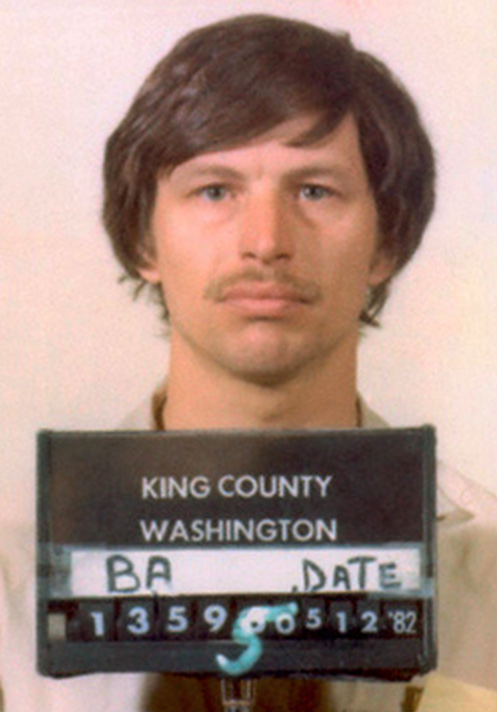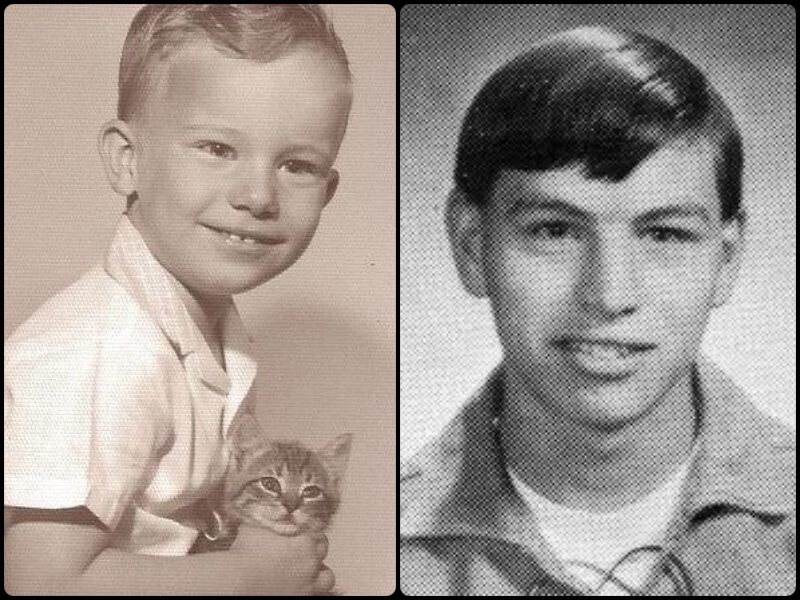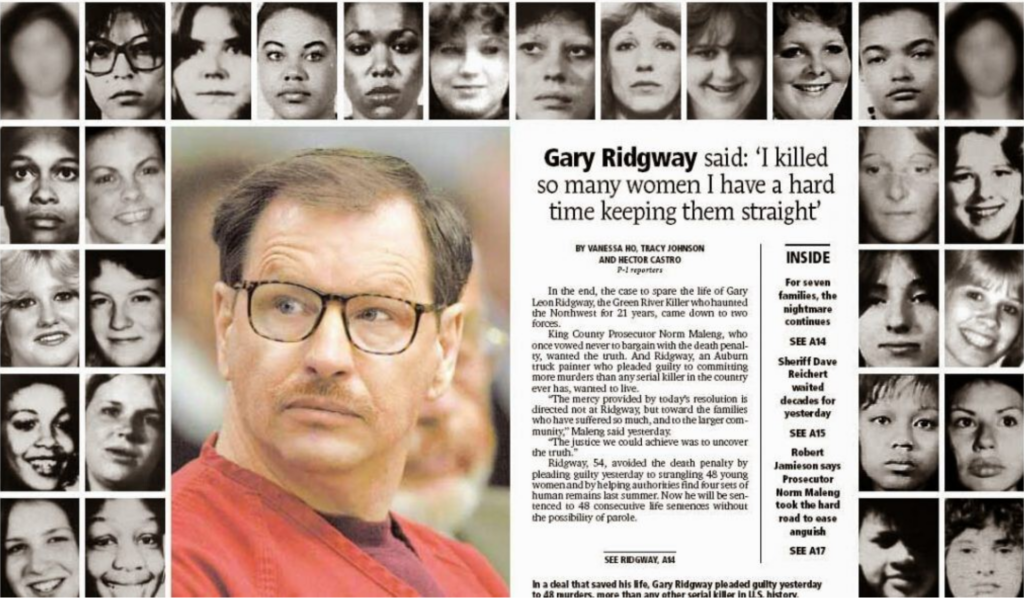Serial killers have always shocked and fascinated people. Over recent decades, we have made huge strides in understanding the motives and psyche of serial killers.
But 40 years ago it was a different world. America was on the cusp of the DNA breakthrough that would lead to solving numerous unsolved murder cases.
But during this pre-DNA era, it was the Wild West for serial killers. One of the most notorious killers of this era was Gary Ridgway.
Ridgway infamously went on a murder spree in the Pacific Northwest during the early 1980s and he continued for over two decades. His victims were often young women involved in sex work or runaways.
He got the nickname “Green River Killer” because he would often dispose of the victims’ bodies along the Green River or in other remote locations. Ridgeway confessed to the murders of 49 women.
However, it is suspected that the actual number of victims may be higher. His crimes became the focus of one of the largest serial killer investigations in U.S. history.

Early Life
Gary Ridgway was born on February 18, 1949, in Salt Lake City, Utah. Like most serial killers, he had a troubled childhood marked by domestic abuse and mental trauma.
His parents, Thomas and Mary Ridgway, would often erupt into violent arguments that young Ridgeway would witness. His father was a bus driver who often complained about the sex workers who would ride his bus at night.
Throughout his childhood, he struggled with dyslexia and social isolation. He often felt uncomfortable and embarrassed around other people his own age. His mother would often shame and humiliate Ridgeway when he would wet the bed, a condition that continued until he was 13 years old.
After graduating from Tyee High School in Washington in 1969, Gary Ridgway enlisted in the U.S. Navy. Ridgway was stationed at the Moffett Federal Airfield in California where he worked as an aviation electrician’s mate, which involved the maintenance and repair of aircraft electrical systems.
As the war in Vietnam began to escalate, Ridgway was later deployed to the war-torn country, where he worked in logistics. While he did bear witness to combat, his specific role involved handling the transportation and supply aspects of military operations.
Like most servicemen serving in Vietnam, he would frequently have sex with local prostitutes. At one point he contracted gonorrhea, an event that upset him greatly but didn’t stop him from engaging in unprotected sex.

Return From the Military
While in the Navy, Ridgway faced some unknown disciplinary issues, suggesting a less-than-smooth military experience. Despite being a troublemaker, he still earned the National Defense Service Medal in recognition of his service.
Upon completing his military service, Ridgway returned to civilian life. Despite the discipline and structure of military service, Ridgway continued to grapple with social isolation and difficulties in forming interpersonal relationships.
Following his return from military service in Vietnam, Ridgway married three times. According to accounts from his ex-wives and former girlfriends, he displayed an insatiable sexual appetite. They reported that Ridgway demanded sex from them multiple times a day and sometimes in public areas.
Ridgway himself admitted to having a fixation with sex workers. Even though he expressed disdain for their presence in his neighborhood, he took advantage of their services regularly.
This complicated love/hate relationship with sex workers could be traced back to Ridgway’s childhood when he would listen to his father’s rants about prostitutes. In a statement read during his plea hearing, Ridgway revealed his strong aversion to prostitutes, claiming that he hated them and didn’t want to pay for sex.
Murder Spree
The exact timeline of when he began his series of killings is somewhat challenging to pinpoint precisely, but the majority of the murders occurred between 1982 and 1984. During this period, Ridgway targeted vulnerable women, primarily those engaged in sex work or runaways, in the vicinity of Seattle and Tacoma, Washington.
Employing deceptive tactics, Ridgway occasionally utilized a photograph of his son to build a false sense of trust in the victim. After engaging in sex with them, Ridgway would strangle them to death and then dump their bodies near the Green River.
Ridgeway wasn’t dumb, even though he was reported to have a low IQ. He knew how to cover his tracks.
Because of the remote locations, the bodies were usually skeletonized by the time authorities found them. Ridgeway also contaminated the scenes with other people’s cigarette butts, used gum, and other garbage in an attempt to confuse police.
Gary Ridgeway’s first known victim was 16-year-old Wendy Lee Coffield. Her body was discovered in the Green River near Seattle on July 15, 1982.
A month later the body of 17-year-old Gisele Ann Lovvorn was found. And a month after that 23-year-old Debra Lynn Bonner. On August 15, three more bodies were discovered.
As more victims were discovered, it became evident that the police had a serial killer on their hands who was targeting vulnerable women in the region. The complex nature of the case prompted law enforcement agencies to collaborate and pool their resources.
The Green River Task Force was formed in response to the alarming number of unsolved murders, particularly those involving young women engaged in sex work.
The Green River Task Force was a multi-agency initiative. It brought together investigators from various local law enforcement agencies, including the King County Sheriff’s Office and the Seattle Police Department.
The task force aimed to centralize information, share intelligence, and coordinate investigative efforts to solve the growing number of murders that they now believed were connected to one person.
To get some insight into the mind of the serial killer, the Green River Task Force interviewed Ted Bundy who was sitting on death row for his own murder spree.
Bundy helped the task force understand the mind of a serial killer. He told them that Ridgeway was using the women for sex because it was easy and he probably returned to their bodies to have sex with them.
Despite the tireless efforts of the Green River Task Force and various law enforcement agencies to apprehend the elusive killer, Ridgeway managed to evade authorities for nearly two decades.
Capture and Arrest
In 2001, advancements in DNA analysis had become a powerful tool in criminal investigations. Technological advancements allowed investigators to reexamine evidence from crime scenes and victims in a more detailed and sophisticated manner.
The Green River Task Force, including forensic experts and investigators, reexamined the evidence collected from the crime scenes and victims over the years. They began compiling a DNA database.
It included samples from crime scenes, victims, and potential suspects. This database helped investigators link cases and identify patterns that were previously unknown.
In November 2001, faced with mounting evidence, Gary Ridgway was arrested at his job site where he was working as a truck painter. He was charged with the murder of four women over 20 years ago.
Ridgeway cooperated with the police and confessed to the murders of numerous women. He provided investigators with detailed information about the locations where he had disposed of the victims’ remains.
In exchange for his cooperation, Ridgway was spared the death penalty and pleaded guilty to 48 counts of murder. A 49th count was later added to Ridgway’s sentence.
The remains of 19-year-old Tracy Winston were discovered on November 20, 2005, by a hiker exploring a wooded area near Highway 18, southeast of Seattle.

Use of DNA Evidence
The Green River Killer case played a pivotal role in advancing the use of DNA evidence in criminal investigations. Ridgway’s case became a landmark example of how DNA technology could be used to connect a suspect to multiple crime scenes. This led to a revolution in forensics and how police collected evidence.
One of the key contributions of the Green River Killer investigation was the development of a comprehensive DNA database. Law enforcement agencies began collecting DNA samples from crime scenes, victims, and potential suspects, creating a valuable resource for cross-referencing and matching genetic profiles.
The case bolstered public and professional confidence in the accuracy and reliability of DNA analysis. This led to its more widespread adoption in criminal investigations across the country.
As a result, the lessons learned from the Green River Killer case contributed to the evolution of forensic science and law enforcement practices. It influenced subsequent high-profile cases and setting a precedent for the use of DNA evidence as a powerful tool in solving crimes and ensuring justice.
Legacy
The murders have inspired numerous Hollywood films including 2005’s “Green River Killer” which explores the investigation into the Green River Killer case. Several documentaries have covered the Green River Killer case, providing insights into the investigation, the victims, and the impact of Ridgway’s crimes.
One notable documentary is “The Green River Killer: Mind of a Monster.”
Even though he was charged with 49 counts of murder, it is widely believed that Ridgway murdered at least 71 girls and women near Seattle and Tacoma, Washington. In court statements, Ridgway stated that he had killed so many that he “lost count”.
References
Gary Ridgway https://en.wikipedia.org/wiki/Gary_Ridgway
Gary Ridgway https://www.biography.com/crime/gary-ridgway
The 20-Year Hunt for The Green River Killer https://uncovered.com/green-river-killer/

